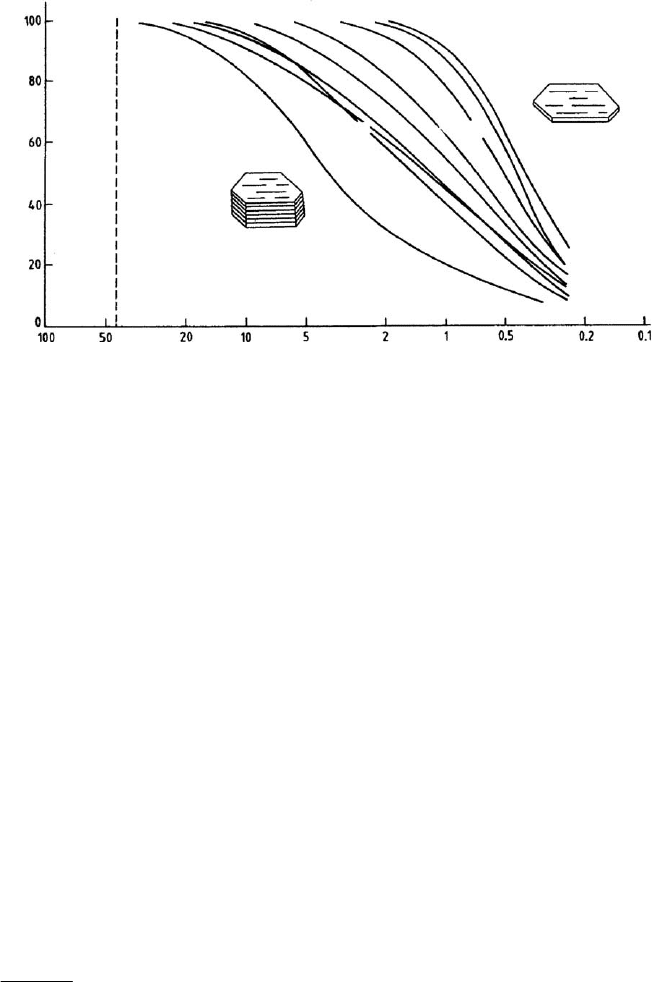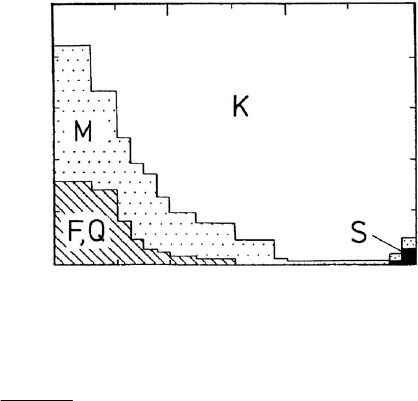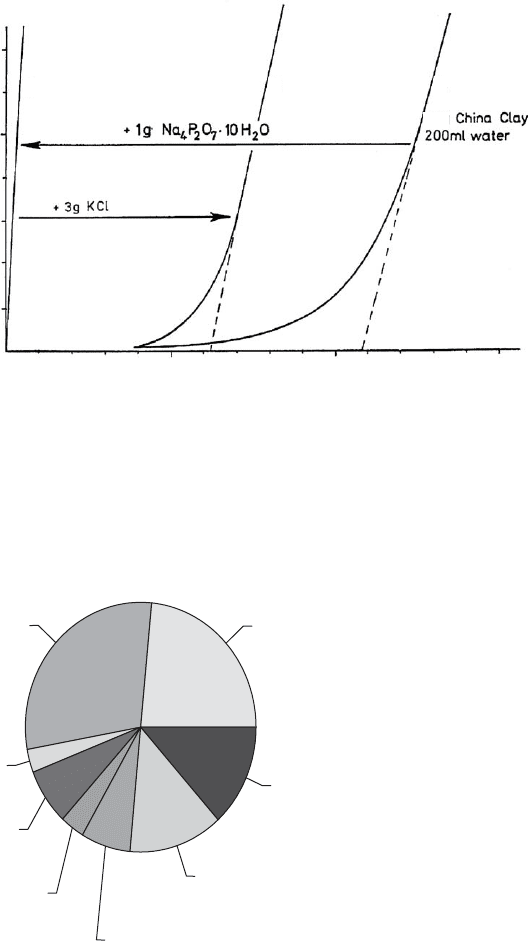Bergaya F. Handbook of Clay Science
Подождите немного. Документ загружается.

9.5. CONCLUSIONS
Microorganisms are ubiquitous on the Earth’s surface. They are especially abun-
dant in biofilms and microbial mats associated with ponds, hot springs, weathered
feldspar, deep-sea floor vents, and mine drainage areas. In these environments
microorganisms can synthesize many kinds of clay minerals, both inside and out side
their living cells. The study of biomineralization and the processes involved requires
a multidisciplinary approach and the application of a range of analytical and
instrumental techniques. At the same time, the results can provide valuable back-
ground information with respect to environmental protection, such as bioremedi-
ation of polluted sites, as well as an insight into the sustainable development of new,
clean energy sources, mineral resources, and biomedical technologies (Tazaki et al.,
2002).
REFERENCES
Asada, R., Tazaki, K., 2000. Observation of bio-kaolinite clusters. Journal of the Clay Science
Society of Japan 40, 24–37 (in Japanese with English abstract).
Brindley, G.W., 1980. Quantitative analysis of clay mixtures. In: Brindley, G.W., Brown, G.
(Eds.), Crystal Structures of Clay Minerals and Their X-ray Identification, Monograph 5.
Mineralogical Society, London, pp. 411–438.
Guggenheim, S., Martin, R.T., 1995. Definition of clay and clay mineral: joint report of the
AIPEA nomenclature and CMS nomenclature committees. Clays and Clay Minerals 43,
255–256.
Mann, S., Sparks, N.H.C., Wade, V.J., 1990. Crystallochemical control of iron oxide bio-
mineralization. In: Skinner, H.C.W., Fitzpatrick, R.W. (Eds.), Biomineralization Processes
of Iron and Manganese—Modern and Ancient Environments. Catena suppl. no. 21,
pp. 21–49.
Moore, D.M., Reynolds, R.C. Jr., 1997. X-ray Diffraction and the Identification and Analysis
of Clay Minerals. Oxford University Press, Oxford.
Morikawa, T., 2002. Bacterial Bio-Weathering of Feldspar at the Dam Reservoir. Graduate
thesis. Kanazawa University, Japan (unpublished, in Japanese).
Roh, Y., Zhang, C.L., Hali, H., Lauf, R.T., Zhou, J., Phelps, T.J., 2003. Biogeochemical and
environmental factors in Fe biomineralization: magnetite and siderite formation. Clays and
Clay Minerals 51, 83–95.
Schwertmann, U., Fitzpatrick, R.W., 1992. Iron minerals in surface environments. In: Skin-
ner, H.C.W., Fitzpatrick, R.W. (Eds.), Biomineralization Processes of Iron and Manga-
nese—Modern and Ancient Environments. Catena suppl. no. 21, pp. 7–30.
Simkiss, K., Wilbur, K.M., 1989. Biomineralization, Cell Biology and Mineral Deposition.
Academic Press, London.
Tawara, K., Yamamura, T., Tazaki, K., 1997. Microorganisms of hydrothermal vents at
Iheya Ridge. Journal of the Mineralogical Society of Japan 26, 81–85 (in Japanese).
Tazaki, K., 1997a. Biomineralization of layer silicates and hydrated Fe–Mn oxides in micro-
bial mats: an electron microscopically studies. Clays and Clay Minerals 45, 203–212.
Chapter 9: Clays, Microorganisms, and Biomineralization496
Tazaki, K. (Ed.), 1997b. A new world in the science of biomineralization: Environmental
biomineralization in microbial mats in Japan. Science Reports of Kanazawa University,
XLII, 1–65.
Tazaki, K., 1999. Architecture of biomats reveals history of geo-, aqua-, and bio-systems.
Episodes 22, 21–25.
Tazaki, K., Asada, R., 2003. Microbes associated with clay minerals: formation of bio-
halloysite. In: Dominguez, E.A., Mas, G.R., Cravero, F. (Eds.), 2001. A Clay Odyssey,
Proceedings of the 12th International Clay Conference, Bahia Blanca, Argentina. Elsevier,
Amsterdam, pp. 569–576.
Tazaki, K., Asada, R., Ikeda, Y., 2002. Quick occurrence of Fe-rich biofilms on the water
surface. Journal of the Clay Science Society of Japan 42, 21–36 (in Japanese with English
abstract).
Tazaki, K., Ishida, H., 1996. Bacteria as nucleation sites for authigenic minerals. Journal of
the Geological Society of Japan 102, 866–878.
Theng, B.K.G., Orchard, V.A., 1995. Interactions of clays with microorganisms and bacterial
survival in soil: A physicochemical perspective. In: Huang, P.M., Berthelin, J., Bollag,
J-M., McGill, W.B., Page, A.L. (Eds.), Environmental Impact of Soil Component Inter-
actions. Lewis Publishers, Boca Raton, FL, pp. 123–143.
Ueshima, M., Mogi, K., Tazaki, K., 2000. Microbes associated with bentonite. Journal of the
Clay Science Society of Japan 39, 171–183 (in Japanese with English abstract).
Ueshima, M., Tazaki, K., 1997. Bacterial biomineralization of clay minerals. Journal of the
Mineralogical Society of Japan 26, 87–92 (in Japanese with English abstract).
Ueshima, M., Tazaki, K., 1998. Bacterial bioweathering of K-feldspar and biotite in granite.
Journal of the Clay Science Society of Japan 38, 68–82 (in Japanese with English abstract).
Ueshima, M., Tazaki, K., 2001. Possible role of microbial polysaccharides in nontronite
formation. Clays and Clay Minerals 49, 292–299.
Yoshizu, K., Tazaki, K., 1997. Role of microorganisms in iron and manganese mineral for-
mation. Journal of the Mineralogical Science Society of Japan 26, 69–72 (in Japanese with
English abstract).
References 497
Handbook of Clay Science
Edited by F. Bergaya, B.K.G. Theng and G. Lagaly
Developments in Clay Science, Vol. 1
r 2006 Elsevier Ltd. All rights reserved.
499
Chapter 10
CLAYS IN INDUSTRY
F. BERGAYA
a
, B.K.G. THENG
b
AND G. LAGALY
c
a
CRMD, CNRS-Universite
´
d’Orle
´
ans, Orle
´
ans Cedex 2, France
b
Landcare Research, Palmerst on North, New Zealand
c
Institut fu
¨
r Anorganische Chemie, Universita
¨
t Kiel, D-24118 Kiel, Germany
This composite chapter is concerned with the industrial applications of clays in
general. Conventional applications, as in ceramics and paper coating, are described
in Chapter 10.1. Catalysis by clay minerals, includi ng their use as catalyst supports,
has received much attention, and is discussed in Chapter 10.2. The versatility of clay
minerals is also reflected by their usage in the formation and preparation of
clay–polymer nanocomposites. As described in Chapter 10.3, these inorganic–
organic hybrid mate rials are the subject of intensive research because of their huge
potential for novel applications.
DOI: 10.1016/S1572-4352(05)01015-9
Handbook of Clay Science
Edited by F. Bergaya, B.K.G. Theng and G. Lagaly
Developments in Clay Science, Vol. 1
r 2006 Published by Elsevier Ltd.
501
Chapter 10.1
CONVENTIONAL APPLICATIONS
C.C. HARVEY
a
AND G. LAGALY
b
a
Institute of Geological and Nuclear Sciences, Wairakei Research Centre, Private Bag
2000, Taupo, New Zealand
b
Institut fu
¨
r Anorganische Chemie, Universita
¨
t Kiel, Otto-Hahn-Platz 6-7, D-24118
Kiel, Germany
Clays and clay minerals are extensively used in a wide variety of industrial ap-
plications (Grim, 1962; van Olphen, 1977; Lagaly and Fahn, 1983 ; Jepson, 1984;
Odom, 1984; Murray, 1986, 1999, 2000, 2003; Harvey and Murray, 1997). Their
usages fall into two contrasting broad classes:
Clays are used because of their inertness and stability. A large variety of industrial
uses are also related to the unique rheological properties of clay and clay mineral
dispersions.
Clays are used because of their reactivity and catalytic activity.
In the following section the various families of clays are discussed in terms of their
inert or reactive applications and their unique rheological properties. In many cases
the different clay types are modified to meet required specifications.
Pure clays do not usuall y occur in nature. In terms of tonnage used, we may
distinguish four classes of clay. The so-called ‘common clays’ enjoy the largest usage
in numerous engineering applications. These clays contain mixtures of different clay
minerals such as illite/smectites, kaolinites, smectites, micas and associated minerals.
This is followed by ‘industrial kaolins’ that contain relatively high amounts of ka-
olinite (kaolins), and sometimes a small proportion of high-quality kaolin minerals.
The third class is ‘bentonite’ with a high montmorillonite (smectite) content. The
fourth class is the ‘palygorskite-sepiolite clays’ that have many sim ilarities to bent-
onites and are specifically used because of their surface properties and reactivity.
The world production of processed kaolins is about 20 million tons/year and that
of bentonites is 13 million tons/year, while palygorskite-sepiolite production is
around 2 million tons/year. The amount of common clays used worldwide is difficult
to estimate since there are no statistics. However, it is likely to exceed many hun-
dreds of millions tons/year. There are also a few deposits of high-purity clays, such
as halloysite (used in high-quality porcelain and catalysis) and hectorite (used
in cosmetics and pharmaceuticals). Their peculiar properties classify them as
DOI: 10.1016/S1572-4352(05)01016-0
high-quality additives rather than bulk industrial minerals. In addition, some finely
ground minerals with similar properties to some industrial clays are frequently in-
cluded in industrial clay surveys. They include vermiculite, mica, talc and pyrophyl-
lite. A brief summary of their uses is included here.
10.1.1. INDUSTRIAL USES
A. Common Clays
Although the technologies associated with the engineering properties of clays are not
covered in this chapter, large tonnages of common clays are used in a wide variety of
engineering applications including road construction, fill, dam construction and in
waste containment. The mineralogy and particle size distribution determine their
engineering properties.
Large tonnages of common clays are used in ceramic production (bricks, tiles,
terracotta, earthenware, stoneware, sewer pipes, paving bricks, refractory bricks,
etc.). Although these clays are typically impure, they contain sufficient clay minerals
to cause them to develop plastici ty and to produce adequate strength, porosit y and
other properties to justify their use. These raw materials may contain high amounts
of mixed-layer clay minerals, notably illite/smectite. As illite/smectite particles can
delaminate to a certain extent depending on their layer charge distribution (see
Chapter 5), the type of illite/sm ectite may influence the ceram ic properties of com-
mon clays, and their behaviour in dispersions (for casting processes, etc.). A small
amount of smectite can be tolerated or is added to improve plasticity. Large amounts
of smectite would give undesirable shrinkage and drying properties. The pre sence of
kaolinite is not desirable in clays used for bricks and tiles because kaolinite would
increase the firing temperature and a light burning colour is not required (Grim,
1962).
B. Kaolins
Kaolins as Filler and Coating Particles
Table 10.1.1 provides a gen eral summary of the uses of clays as inert components in
industrial systems (Murray, 1986, 1999, 2000; Harvey and Murray, 1997; Harvey,
1997). Amongst the earliest industrial uses of clays are water-based systems such as
paper or water-based paints where the hydrophilic nature of clays enables them to
readily disper se in such systems. However, kaolins were long used a s fillers for
plastics and rubber. To make the hydrophilic surface of the clay mineral compatible
with the organic material, the surface is modified by reacting with organic com-
pounds, in most cases by grafting (see Chapter 7.3). If the clay mineral particles are
highly dispersed in the polymer matrix and the adhesion between the filler particles
Chapter 10.1: Conventional Applications502

and the matrix is good, the ka olinite particles act as active fillers, i.e., they improve
certain mechanical properties of the polymers (Lagaly, 1999).
Modern developments in this field not only aim to increase the bonding strength
between the filler particles and the polymer matrix but also to produce clay min-
eral–polymer nanocomposites where the fully delaminated mineral is dispersed in the
matrix (see Chapter 10.3).
Kaolin, bentonite, palygorskite and sepiolite are used as carri ers and diluents of
pesticides (insecticides, fungicides, herbicides). Enhanced application of herbicides
requires particular formulations based on modified clay minerals (see Chapter 11.2).
The largest amounts of processed kaolins (more than 60% of the word produc-
tion) are used in the paper industry as fillers within the network of cellulose fibres
and as coating particles. The technical requirements for filler clays are significantly
less than for kaolinite particles in the coating colours. Gloss, brightness, opa city and
smoothness generally improve with increasing coat mass and decreasing particle size.
The p2 mm fraction is particularly important in coating kaolins and high-glossing
paint kaolins. More than 70% (w/w) of the coating particles should be smaller than
2 mm. Very finely divided kaolins can cause technical problems. Filler clays typically
Table 10.1.1. Uses of clay minerals as inert components
Clay family Industry Use
Kaolin Paper, plastics, rubber Filler
Pesticides Carrier, diluent
Vermiculite Building industry Heat insulation, sound dissipation
Package industry Shock proof materials, thermal
protection, liquid absorption
Foundries thermal protection
Mica Electrical industry Insulation
Paints UV-, heat-stable and under-water
paints
Cosmetics Nacreous pigments
Coating Corrosion proof, polymer coatings,
underseal
Talcum, pyrophyllite Plastics, rubber, paper
industry
Filler
cosmetics, pharmaceutics Powders, pastes, ointments, lotions
refractory industry Refractories
Palygorskite, sepiolite Pesticides Carrier for insecticides and
herbicides
Chemical industry Catalyst carrier, filter material,
anti-caking agent
Cosmetics, plastics Filler
10.1.1. Industrial Uses 503

have 50–70% particles >2 mm(Jepson, 1984; Murray, 1986, 1999, 2000), the op-
timum particle size for lodging within paper fibres being 5–7 mm. Typical particle size
distributions of industrially processed filler and coating kaolins from the sedimentary
kaolin deposits in Georgia (USA) are illustrated in Fig. 10.1.1.
Coating of paper is done at very high speeds (1200 m/min and even more), and
using large machines (Bundy, 1993). As such, it requires an exact tuning of the
rheological properties of the highly concentrated slurries. In blade coating the rate of
shear can reach 10
6
s
1
along the line of contact of the blade with the paper. The
relation between bulk kaolin properties and coating colour rheology is complex.
Particle shape, size, size distribution and particle packing are critical factors. For the
same clay content, dispersions of thin, large particles have higher viscosities than
those of blocky particles. The more platy the particle shape, the lower is the shear
rate at which shear thickening starts.
To prepare homogeneous slurries of kaolin with up to 70% (w/w) solids, anionic
macromolecules, mainly polyphosphates and polyacrylates,
1
are added. This en-
hances the negative charge density at particle edges, providing steric stabilisation to
the dispersion (see Chapter 5). It is necessary to select appropriate size fractions and
particle shapes to obtain the required rheological properties (yield value, viscosity,
thixotropy). One also has to consider the interaction of the coating particles with the
thickeners (often carboxy methylcellulose and starch) as this plays a key role in
controlling the rheological and dewatering properties (Li et al., 2001).
filler
coating
thick particles
thin particles
325 mesh
mass percent finer than
e
q
uivalent s
p
herical diameter (
µ
m)
Fig. 10.1.1. Typical particle size distribution of filler and coating grade kaolins. From
Murray (1986).
1
Some polyphosphate containing kaolin slurries can form gels within a few hours if left undisturbed
producing discharge problems. Gelation is retarded or impeded by adding sodium polyacrylates.
Chapter 10.1: Conventional Applications504

Kaolins in Ceramics
A major use for high-purity kaolins is for ceramic products such as porcelain, bone
china, vitreous sanitary ware and earthenware. Low-quality kaolins are also used as
fillers in a wide range of ceramic products including brick, pipes and tiles. Refractory
clays are dominantly composed of kaolins with low levels of iron, alkali and alkaline
earth cations. High levels of such metals would reduce the fusion point.
Delamination of kaolinite particles
2
improves the quality of porcelain. This re-
action was used by Chinese ceramists to produce very thin (‘egg-she ll’) porcelain of
high mechanical stability (see Chapter 7.3). Delamination was also used in the pro-
duction of speciality paper clays. Delamination of large particle-size kaolin stacks
can convert filler clay into high-surface area platelets with superior opacity in light-
weight coatings (Bundy, 1993).
The presence of smectit es in commercially exploited kaolin resources is undesir-
able for most industrial applic ations. The smectites may therefore have to be re-
moved in order to meet the required specifications. As these minerals are generally
concentrated in the finest size fractions (o 0.5 mm) of kaolins (Fig. 10.1.2), size
fractionation can help to reduce the smectite content. Chemical modification of the
smectites was also proposed to reduce their negative effect (Jepson, 1984).
Historically, mainly in China and Eastern Asia, clays and kaolins for the pro-
duction of fine ceramics were traditionally matured by placement in humid pits for
several years. The improvement in properties is caused by the modificat ion of par-
ticle size (and possibly composition) through the action of microorganisms. This
100 10 1 0.1
e
q
uivalent s
p
herical diameter (
µ
m)
80
40
0
composition (% mass)
Fig. 10.1.2. Variation in mineral composition with particle size for Cornish kaolin. F ¼ feld-
spars; Q ¼ quartz; M ¼ mica; S ¼ smectite; K ¼ kaolinite. From Jepson (1984).
2
In a strength sense ‘delamination’ describes the disarticulation of the particles into single silicate layers
(see Chapter 5). In industrial applications ‘delamination’ stands for the dissociation of aggregates into
single particles or smaller aggregates.
10.1.1. Industrial Uses 505

beneficiation process is currently attracting the attention of scient ists (Groudeva and
Groudev, 1995; Lee et al., 2002).
Ceramic masses can be shaped because of the unique ability of clay mineral
particles to form card-house or band-type networks (see Chapter 5). On the other
hand, the ease with which clay minera l particles form stable colloidal disper sions also
allows the production of ceramics by casting, especially porcelain and vitreous san-
itary ware. The deflocculated slip (total solid content X70% (w/w) is poured into a
porous plaster mould so that a filter cake builds up on the plaster surface. The mould
is inverted, and the excess slip is allowed to drain. After de-watering in the mould,
the cast is removed, and, after a few further steps, is sprayed with glaze and fired
(Jepson, 1984). This technique needs fluid colloidal dispersions with clay contents as
high as possible. Liquefaction requires the addition of sodium salts and a pH above
6. At the same water content, a sodium kaolinite dispersion can be fluid whereas
calcium kaolinite forms a plastic mass (see Chapter 5). This behaviour was first
described by Justus von Liebig (1865). Fine ceramics produced by slip casting com-
monly have a higher dry breaking strength than shaped ceramics. The filter cake
built up during slip casting consists of kaolinite particles that are more densely
packed in parallel orientation as compared with moulded plastic masses in the
presence of calcium ions (Hofman n, 1962a).
In technical processes the charge on particle edges is changed from positive to
negative by addition of multivalent anions, particularly oligo- and poly-phosphates
as well as polyanions like polyacrylate and less well-defined macromolecular com-
pounds such as humic substances. These additives often impart a certain amount of
steric stabilization to the dispersion (see Chapter 5). One of the most effective dis-
persants for modern high-performance ceramics is oxidized fish oil (Bo
¨
hnlein-MauX
et al., 1992). Liquefaction of a mass of 100 g kao linite (‘China clay’) in 200 ml water
by 1 g tetrasodium diphosphate (Na
4
P
2
O
7
10 H
2
O) is illustrated in Fig. 10.1.3. The
fluid dispersion can sti ffen again by the addition of salts such as KCl (in this case
3 g/100 g clay), causing the clay mineral particles to coagulate (flocculate).
C. Bentonites
World production tonnages for bentonites are very difficult to obtain. Our best
estimate is 13 million tons and the major usages are iron ore pelletizing, foundry
mouldings and oil well drilling (Fig. 10.1.4). However, the use of bentonite in nu-
merous environmental applications is growing fast. Large volumes are needed for
filtering, decolourizing and clarifying (mostly in form of bleaching earths), pelletising
animal feed, as pet litter adsorbent,
3
pesticide carrier and oil and grease adsorbent.
Smaller amounts of bentonites are needed for paints, pharmaceutical and cosmetic
uses, waste disposal, lubricants, as additives for cement and mortar, as catalysts and
3
The effectiveness of clays for pet litter may also be related to the deactivation of enzymes that convert
urea to ammonia (W. P. Moll, personal communication, see Chapter 11.1).
Chapter 10.1: Conventional Applications506

foundry
23.5%
adsorbents
29.4%
refining
3.1%
agronomy
7.3%
building industry
3.4%
other
6.9%
drilling fluids
13.2%
iron ore pelletising
13.3%
Fig. 10.1.4. Use of bentonite. World production may be 13 million tons in 1993 (Courtesy N.
Schall, Su
¨
d-Chemie AG, Germany).
0 50 100 150
shear stress (Pa)
500
100
0
shear rate (s
-1
)
100g
B
C
A
Fig. 10.1.3. Liquefaction of kaolin by tetrasodium diphosphate. A 100 g China Clay in 200 ml
water. B Liquefaction by addition of 1 g Na
4
P
2
O
7
10 H
2
O, C again stiffening by addition of 3 g
KCl. Data from M. Mu
¨
ller-Vonmoos, ETH Zurich. From Jasmund and Lagaly (1993).
10.1.1. Industrial Uses 507
